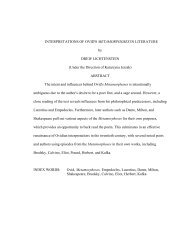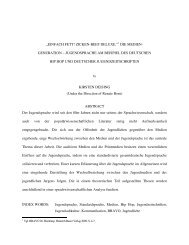RED BOAT TROUPES AND CANTONESE ... - University of Georgia
RED BOAT TROUPES AND CANTONESE ... - University of Georgia
RED BOAT TROUPES AND CANTONESE ... - University of Georgia
You also want an ePaper? Increase the reach of your titles
YUMPU automatically turns print PDFs into web optimized ePapers that Google loves.
Recitatives in a Cantonese opera include speech in metrical rhythms, recitation <strong>of</strong> poems,<br />
heightened speech, and speech with a formula, which is usually recited quickly with percussion<br />
accompaniment. The orchestra gives cues to singer in approaching certain oral delivery. The<br />
kwun fa (rolling flower) style recitative is announced by the orchestra in either one <strong>of</strong> two types<br />
<strong>of</strong> short motifs. Other recitatives include so pak lam (counting white olives) in narrating a story,<br />
hau goo (hau-mouth, goo-story) and si pak (si-poem, pak-recite). Sometimes two different tune<br />
types are sung consecutively with little break, the rhythm changes suddenly, and the melody<br />
changes. This stimulates the audiences’ attention.<br />
Three beats in one measure occasionally appears in the music, but the following meters are<br />
most common in Cantonese Opera:<br />
1. The slow rhythm (maan ban) – similar to the 4/4 in the western system<br />
2. The moderate rhythm (zong ban)– similar to the 2/4 in the western system<br />
3. The water rhythm (lau seung ban)– one beat in a measure<br />
4. The freedom rhythm (san ban) – the performer has liberty to sing according to<br />
his/her wish.<br />
Cantonese singers alternate between palms facing upward and facing downward in counting<br />
beats while practicing a song. While doing this, touching the thumb to the second finger, index<br />
finger or ring finger also expresses the number <strong>of</strong> beats in a measure.<br />
Most songs are sung in a key with the tonic some microtones higher than concert pitch C,<br />
which is called zing sin, 110 and its relative dominant as tonic, the fan sin. 111 B-flat and F are<br />
sometimes used as tonics. Mr. Wong Toa said that pr<strong>of</strong>essionals used to sing with C# as tonic,<br />
but lately they lowered it to C. He lamented that pr<strong>of</strong>essionals today do not practice as much as<br />
110 Meaning on the line.<br />
111 Meaning opposite line.<br />
46






